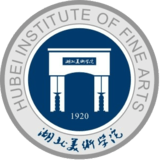Hubei Institute of Fine Arts
| 湖北美术学院 | |
 | |
| Motto | 崇德 笃学 敏行 致美 |
|---|---|
Motto in English | Uphold morals, Devoted to study, Quick in action and Aspire to beauty |
| Type | Public (provincial) |
| Established | 1920 |
| President | Xu Yongmin (徐勇民) |
Academic staff | 400 |
| Students | 6,400 |
| Location | Wuhan, Hubei, China |
| Campus | Urban, Suburban, 800 mu (亩) |
| Website | www.hifa.edu.cn |
Hubei Institute of Fine Arts (HIFA, simplified Chinese: 湖北美术学院; traditional Chinese: 湖北美術學院; pinyin: Húběi Měishù Xuéyuàn; colloquially 湖美, pinyin: Húměi) is an art college in the People's Republic of China (PRC). It is regarded as one of the best and most selective academies of fine arts in China. Its history dates back to 1920, making it the first private art school in modern China. As one of the three oldest art colleges, it is also one of the cradles of higher education of fine arts in modern China. It is located in Hubei Province's capital Wuhan, known as "the thoroughfare leading to nine provinces".
History
The academy dates back to Wuchang Fine Arts School (Simplified Chinese: 武昌美术学校; Traditional Chinese: 武昌美術學校; Pinyin: Wǔchāng Měishù Xuéxiào), which was founded in 1920 by Jiang Lanpu, Tang Yijing and Xu Ziheng. In 1923, it was renamed Wuchang Specialised School of Fine Arts(Simplified Chinese: 武昌美术专门学校; Traditional Chinese: 武昌美術專門學校; Pinyin: Wǔchāng Měishù Zhuānmén Xuéxiào) and became one of the three oldest art academies in modern China. In 1930, it was renamed Private Wu Chang College of Fine Arts (Simplified Chinese: 私立武昌艺术专科学校; Traditional Chinese: 私立武昌藝術專科學校; Pinyin: Sīlì Wǔchāng Yìshù Zhuānkē Xuéxiào). In the mid-1930s, the college reached the heyday in terms of size, talent training and academic achievements, and became one of the most important art education bases in China. During the War of Resistance Against Japan, Wu Chang College of Fine Arts moved to Jiangjin, Sichuan Province in 1938 and returned to Wuhan after the victory. Despite the great difficulties during the anti-Japanese war, the college reached its another peak of development. The college made tremendous contributions to the establishment and development of the modern art education in China and laid the solid foundation for the art education in PRC. After the founding of PRC in 1949, Wu Chang College of Fine Arts was merged into Central Plains University (Simplified Chinese: 中原大学; Traditional Chinese: 中原大學; Pinyin: Zhōngyuán Dàxué), Hubei Education College (Simplified Chinese: 湖北教育学院; Traditional Chinese: 湖北教育學院; Pinyin: Húběi Jiàoyù Xuéyuàn) and Central China Normal College (Simplified Chinese: 华中师范学院; Traditional Chinese: 華中師範學院; Pinyin: Huázhōng Shīfàn Xuéyuàn) successively. In 1977, it developed into an independent college——Hubei Art Academy (Simplified Chinese: 湖北艺术学院; Traditional Chinese: 湖北藝術學院; Pinyin: Húběi Yìshù Xuéyuàn), which consisted of the Fine Arts Division and the Music Division. In 1985, with the approval of the then State Education Commission, the Fine Arts Division of Hubei Art Academy became Hubei Institute of Fine Arts, shaping the new setup of higher education of fine arts in contemporary China and opening the new chapter of development in the history of the academy.
Academic profile
Hubei Institute of Fine Arts is an academy combining art education, creation, research and industry, which enjoys a pioneering and representative key place in higher education of fine arts in central China. By the end of 2009, the academy has 12 departments and schools, and they are the Department of Traditional Chinese Painting, the Department of Oil Painting, the Department of Printmaking, the Department of Sculpture, the Department of Mural Painting, the Department of Design, the Department of Industrial Design, the Department of Costume, the Department of Environmental Art and Design, the Department of Fine Arts Education, the Department of Fine Arts Studies and the Animation School. Boasting a complete range of art programs, the academy offers the postgraduate programs, undergraduate ones and junior college ones as well. Hubei Institute of Fine Arts enjoys a high academic status and a constellation of celebrated artists have taught and are teaching here. It has also brought up a great number of well-known artists. In October, 2009, the new campus at Canglongdao, Jiangxia, came into use, standing out as one of the notable landmarks in the history of the academy.
Notable alumni
- Wei Guangqing
- Yuan Xiaofang
- Cao Dan
- Ma Liuming
- Xiao Feng
- Zeng Fanzhi
- Li Chang
- Wan Yisheng
- Xu Wentao
- Zheng Qian
See also
References